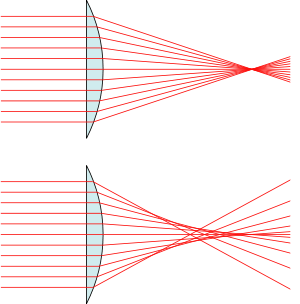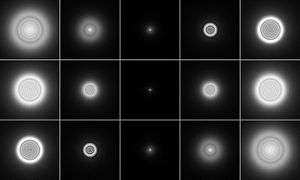Spherical aberration
| Optical aberration |
|---|
|
Spherical aberration is an optical effect observed in an optical device (lens, mirror, etc.) that occurs due to the increased refraction of light rays when they strike a lens or a reflection of light rays when they strike a mirror near its edge, in comparison with those that strike nearer the centre. It signifies a deviation of the device from the norm, i.e., it results in an imperfection of the produced image.

The bottom example depicts a real lens with spherical surfaces, which produces spherical aberration: The different rays do not meet after the lens in one focal point. The further the rays are from the optical axis, the closer to the lens they intersect the optical axis (positive spherical aberration).
(Drawing is exaggerated.)

A spherical lens has an aplanatic point (i.e., no spherical aberration) only at a radius that equals the radius of the sphere divided by the index of refraction of the lens material. A typical value of refractive index for crown glass is 1.5 (see list), which indicates that only about 43% of the area (67% of diameter) of a spherical lens is useful. It is often considered to be an imperfection of telescopes and other instruments which makes their focusing less than ideal due to the spherical shape of lenses and mirrors. This is an important effect, because spherical shapes are much easier to produce than aspherical ones. In many cases, it is cheaper to use multiple spherical elements to compensate for spherical aberration than it is to use a single aspheric lens.
"Positive" spherical aberration means peripheral rays are bent too much. "Negative" spherical aberration means peripheral rays are not bent enough.
The effect is proportional to the fourth power of the diameter and inversely proportional to the third power of the focal length, so it is much more pronounced at short focal ratios, i.e., "fast" lenses.

In lens systems, the effect can be minimized using special combinations of convex and concave lenses, as well as using aspheric lenses or aplanatic lenses.
For simple designs one can sometimes calculate parameters that minimize spherical aberration. For example, in a design consisting of a single lens with spherical surfaces and a given object distance o, image distance i, and refractive index n, one can minimize spherical aberration by adjusting the radii of curvature and of the front and back surfaces of the lens such that

For small telescopes using spherical mirrors with focal ratios shorter than f/10, light from a distant point source (such as a star) is not all focused at the same point. Particularly, light striking the inner part of the mirror focuses farther from the mirror than light striking the outer part. As a result the image cannot be focused as sharply as if the aberration were not present. Because of spherical aberration, telescopes shorter than f/10 are usually made with non-spherical mirrors or with correcting lenses.
See also
- Achromatic lens
- Aspheric lens
- Aberration in optical systems
- Cartesian oval
- Hubble Space Telescope
- Maksutov telescope
- Parabolic reflector
- Ritchey-Chrétien telescope
- Schmidt corrector plate
- Soft focus
External links
- Spherical aberration at vanwalree.com, PA van Walree, viewed 28 January 2007.
- http://www.telescope-optics.net/spherical1.htm